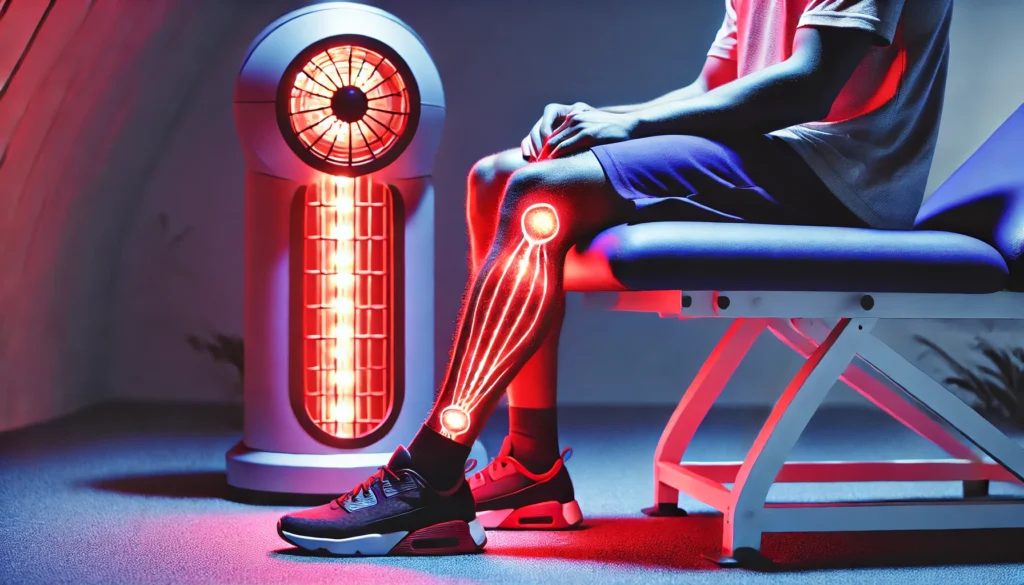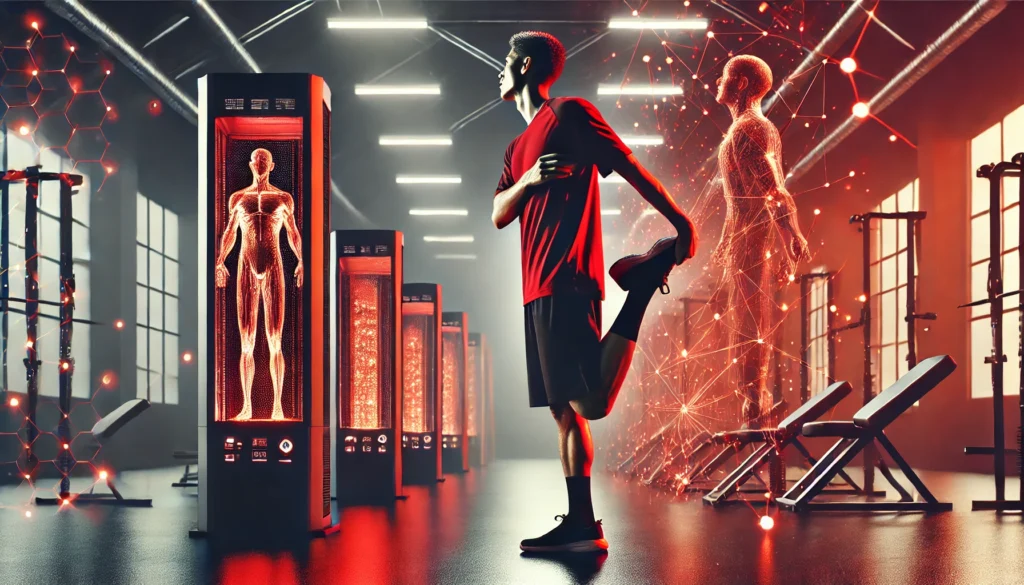Introduction: Unlocking the Power of Infrared Light for Athletic Recovery
Athletes and fitness enthusiasts continually seek advanced methods to enhance performance, expedite recovery, and prevent injuries. Among the emerging modalities gaining widespread attention is infrared therapy, a revolutionary approach that leverages light energy to stimulate deep tissue healing. The benefits of infrared treatment have positioned it as a cornerstone in modern recovery strategies, offering a non-invasive and scientifically backed solution to improve muscle repair, circulation, and overall regeneration.
You may also like: Red Light Therapy for Muscle Recovery: How Athletes Can Speed Healing and Enhance Performance
Infrared light therapy, often delivered through infrared heat lamp therapy or infrared treatment lamps, operates by penetrating the skin and reaching muscles, tendons, and joints with therapeutic warmth. This targeted approach aids in accelerating cellular repair, reducing inflammation, and improving circulation—critical factors in athletic recovery. But what does infrared light do that sets it apart from other recovery modalities? Understanding the underlying mechanisms and applications of this technology can empower athletes to integrate it effectively into their routines.
As interest in infrared lamp benefits continues to grow, researchers and health professionals are uncovering deeper insights into its physiological effects. From enhancing mitochondrial function to optimizing oxygen delivery to tissues, the spectrum of advantages is vast. This article explores how infrared treatment can be a game-changer in performance enhancement and recovery, providing a comprehensive analysis of its mechanisms, applications, and real-world impact on athletic success.
The Science Behind Infrared Light Therapy
To fully appreciate the potential of infrared therapy, it is essential to understand how does infrared light work at a cellular level. Unlike traditional heat therapy, which primarily warms the skin’s surface, infrared light penetrates deeper, reaching tissues that conventional methods cannot. The energy from IR therapy lamps is absorbed by cells, stimulating biological processes that promote healing and rejuvenation.
One of the fundamental benefits of infrared therapy is its ability to enhance mitochondrial function. Mitochondria, often referred to as the powerhouse of the cell, play a crucial role in energy production. Infrared light stimulates these organelles to generate adenosine triphosphate (ATP), the primary energy currency of the body. Increased ATP production accelerates cellular repair and regeneration, making it particularly beneficial for athletes recovering from intense training sessions.
Furthermore, infrared bulb therapy has been shown to trigger vasodilation, the widening of blood vessels, which improves circulation and oxygen delivery to tissues. This enhanced blood flow reduces muscle fatigue, speeds up the removal of metabolic waste, and promotes overall tissue healing. By facilitating deeper penetration of heat, using infrared light can also alleviate stiffness and enhance flexibility—key factors in preventing injuries and optimizing performance.
How Infrared Therapy Enhances Muscle Recovery
For athletes, muscle recovery is a critical component of sustained performance and injury prevention. Infrared treatment plays a pivotal role in accelerating this process by addressing inflammation, muscle tension, and oxidative stress. Following intense physical exertion, muscle fibers experience microscopic tears that require time and energy to repair. By incorporating infrared treatment lamps into recovery protocols, athletes can enhance the speed and efficiency of this healing process.
One of the most compelling infrared light benefits is its ability to reduce inflammation. Post-exercise inflammation is a natural response triggered by muscle damage, but excessive inflammation can lead to prolonged soreness and impaired function. Infrared therapy mitigates this issue by modulating the body’s inflammatory response, reducing swelling, and promoting faster tissue recovery. Athletes using IR therapy lamps often report significant reductions in delayed onset muscle soreness (DOMS), allowing them to train harder and more frequently.
Additionally, infrared heat lamp therapy improves muscle elasticity by promoting collagen production. Collagen is a vital protein that maintains the structural integrity of muscles, tendons, and ligaments. By stimulating collagen synthesis, infrared treatment enhances tissue resilience and minimizes the risk of strains or tears. This is particularly beneficial for endurance athletes and weightlifters, who place high levels of stress on their musculoskeletal systems.

Injury Rehabilitation and Pain Management with Infrared Therapy
Beyond muscle recovery, infrared treatment is an effective tool for injury rehabilitation and pain management. Athletes frequently encounter soft tissue injuries, joint pain, and chronic conditions that hinder their ability to perform at their best. Infrared bulb therapy provides a drug-free, non-invasive solution to manage pain and accelerate healing.
Studies have demonstrated that using infrared light can significantly reduce pain associated with conditions such as tendinitis, arthritis, and muscle strains. This is achieved through its ability to increase blood circulation and oxygenation, delivering essential nutrients to injured tissues. Furthermore, infrared therapy stimulates the release of endorphins, the body’s natural painkillers, providing relief without the need for pharmaceuticals.
Infrared treatment lamps are particularly beneficial for addressing joint pain and stiffness, common issues among athletes engaged in high-impact sports. The deep heat penetration alleviates discomfort and improves joint mobility, enabling athletes to regain full function more quickly. Many professional sports teams and rehabilitation centers now incorporate IR therapy into their recovery programs to optimize healing outcomes.
The Role of Infrared Therapy in Enhancing Performance
In addition to its recovery benefits, infrared therapy can directly enhance athletic performance by optimizing muscular endurance, flexibility, and overall energy levels. By improving circulation and oxygen utilization, athletes experience greater endurance and reduced fatigue during training sessions and competitions.
One of the lesser-known infrared lamp benefits is its impact on neuromuscular function. Regular infrared treatment has been shown to enhance nerve conductivity, improving coordination and reaction time. This can be particularly advantageous in sports that require agility, precision, and quick reflexes.
Moreover, infrared therapy supports immune function, reducing the likelihood of infections and illnesses that can interrupt training schedules. Athletes who incorporate infrared heat lamp therapy into their routines often report improved recovery between workouts, allowing for more consistent and effective training cycles.
Practical Applications: Integrating Infrared Therapy into an Athlete’s Routine
For those interested in experiencing the benefits of infrared therapy firsthand, several practical methods can be incorporated into daily recovery routines. One of the most accessible options is the use of infrared therapy lamps at home or in training facilities. These devices allow athletes to target specific muscle groups and joints, providing focused relief and relaxation.
Infrared saunas are another popular modality, offering full-body exposure to infrared heat in a controlled environment. Many elite athletes utilize infrared sauna sessions post-training to promote detoxification, reduce muscle tension, and enhance overall recovery. The combination of infrared light and controlled heat creates a synergistic effect that accelerates tissue repair and relieves stress.
For those recovering from injuries, infrared therapy can be integrated into physical therapy sessions, complementing other rehabilitation techniques such as massage, stretching, and cryotherapy. Many sports therapists now recommend infrared treatment as part of a comprehensive recovery strategy, emphasizing its ability to promote long-term musculoskeletal health.
Frequently Asked Questions (FAQ) on Infrared Light Therapy for Athletic Recovery
1. How does infrared heat lamp therapy differ from traditional heating methods?
Infrared heat lamp therapy is distinct from traditional heating methods because it penetrates deeper into muscles and tissues rather than just warming the skin’s surface. Conventional heating pads or hot water bottles primarily provide superficial warmth, which can offer temporary relief but does not significantly enhance cellular repair. Infrared treatment lamp technology, on the other hand, emits wavelengths that stimulate mitochondrial function, leading to increased ATP production and accelerated tissue recovery. This deeper penetration promotes long-term healing by reducing inflammation, improving circulation, and alleviating muscle stiffness more effectively than surface heat applications. Athletes utilizing infrared bulb therapy often experience faster recovery times and enhanced flexibility, making it a superior choice for those engaged in high-intensity training.
2. What does infrared light do to improve circulation and oxygenation?
Infrared light benefits athletes by significantly improving blood flow and oxygen delivery to tissues. When exposed to IR therapy lamps, blood vessels expand in a process called vasodilation, which allows for better nutrient exchange and more efficient removal of metabolic waste. This increased circulation helps muscles receive the oxygen they need to function optimally, reducing fatigue and minimizing post-exercise soreness. Additionally, improved oxygenation supports faster healing in cases of muscle strain or minor injuries, making infrared treatment a valuable addition to an athlete’s recovery regimen. The enhanced circulation also aids in joint health, reducing stiffness and promoting overall mobility.
3. Is infrared light good for you when used frequently in recovery sessions?
Yes, regular infrared therapy can be highly beneficial when integrated properly into an athlete’s recovery routine. Using infrared light consistently has been shown to lower oxidative stress, improve muscular endurance, and support immune function, all of which contribute to long-term athletic performance. However, balance is key, as excessive exposure without proper hydration and rest may lead to mild dehydration or over-relaxation of muscles. Many sports professionals recommend incorporating infrared treatment lamps into a structured recovery plan, ensuring that sessions are spaced appropriately to maximize their regenerative effects. Proper hydration and maintaining electrolyte balance further optimize the benefits of using infrared light for recovery.
4. Can infrared lamp benefits extend beyond muscle recovery?
Absolutely. While infrared therapy is widely recognized for its role in athletic recovery, its benefits extend to joint health, stress reduction, and even improved sleep quality. The heat from infrared treatment lamps helps reduce stiffness in joints, making it particularly beneficial for individuals with arthritis or chronic joint pain. Additionally, the soothing warmth promotes relaxation by lowering cortisol levels, a hormone associated with stress. Many athletes report improved sleep patterns after regular infrared sessions, as the deep-tissue relaxation helps regulate melatonin production. This combination of physiological and psychological benefits makes infrared therapy a well-rounded tool for overall well-being.

5. How does infrared bulb therapy help prevent injuries?
Using infrared light proactively rather than just for post-workout recovery can help prevent injuries by increasing tissue flexibility and circulation. Pre-exercise infrared sessions warm up muscles and joints more effectively than traditional stretching alone, reducing the risk of strains and tears. Additionally, regular infrared treatment strengthens connective tissues by promoting collagen production, ensuring that tendons and ligaments are more resilient to stress. Athletes who incorporate infrared bulb therapy into their routine often experience improved range of motion and less susceptibility to overuse injuries. This makes infrared therapy a preventive as well as a restorative tool for maintaining peak performance.
6. How does infrared treatment compare to cold therapy for recovery?
Infrared treatment and cold therapy serve different purposes in athletic recovery. While infrared heat lamp therapy enhances circulation, promotes relaxation, and accelerates muscle repair, cold therapy (such as ice baths) reduces acute inflammation and numbs pain. Many athletes alternate between the two methods to balance the benefits—using infrared therapy to boost long-term recovery and cold therapy for immediate relief from swelling or injuries. The key is to understand the body’s needs at different recovery stages: infrared treatment lamps are ideal for muscle relaxation and regeneration, whereas cold therapy is best suited for minimizing swelling after high-impact activities. Combining both strategically can optimize an athlete’s overall recovery process.
7. What are the long-term benefits of using infrared light therapy for athletes?
Long-term use of infrared therapy offers cumulative benefits, including improved cellular efficiency, enhanced endurance, and reduced muscle fatigue over time. By regularly exposing muscles and joints to infrared light, athletes can experience better mitochondrial function, which leads to greater energy production at the cellular level. This translates to increased stamina during workouts and faster recovery between sessions, allowing for higher training volume without overtraining risks. Additionally, the ability of infrared treatment lamps to support collagen production helps maintain joint integrity, reducing the likelihood of age-related wear and tear. These advantages make infrared therapy a sustainable recovery strategy for athletes at all levels.
8. Are there any risks associated with using infrared light too often?
While infrared light therapy is generally safe, excessive exposure without proper hydration and recovery balance can lead to temporary side effects. Overuse of IR therapy lamps can cause mild dehydration due to increased sweating, which is why it’s essential to drink adequate fluids before and after sessions. Additionally, prolonged exposure to high-intensity infrared treatment without breaks may cause slight fatigue, as muscles remain in a relaxed state for extended periods. However, these risks are minimal and easily managed with proper usage guidelines. Most athletes find that using infrared light therapy 3-5 times per week, depending on training intensity, provides optimal benefits without adverse effects.
9. How does infrared light impact mental focus and cognitive function?
Beyond its physical benefits, infrared therapy can enhance mental clarity and focus, which are critical for peak athletic performance. The relaxation effect induced by infrared treatment lamps helps regulate stress hormones and improve sleep quality, both of which contribute to better cognitive function. Furthermore, increased blood flow to the brain during infrared therapy sessions ensures optimal oxygen and nutrient delivery, supporting faster reaction times and decision-making abilities. Some studies suggest that regular infrared exposure may also aid in reducing mental fatigue, making it a valuable tool for athletes who require sustained concentration in their sports. Using infrared light in recovery routines not only benefits the body but also sharpens the mind.
10. What future advancements can we expect in infrared therapy for athletic recovery?
As research continues to explore the full potential of infrared therapy, we can expect advancements in device efficiency, personalized infrared protocols, and integration with wearable technology. Emerging innovations include portable IR therapy lamps with AI-driven intensity adjustments tailored to an individual’s recovery needs. Additionally, combining infrared treatment with other modalities like cryotherapy and electrical muscle stimulation could enhance its effectiveness. Future applications may also involve using infrared therapy in conjunction with biometric monitoring to track recovery progress in real time. These developments will make infrared therapy even more accessible and effective for athletes looking to optimize their performance and longevity.

Conclusion: The Future of Infrared Therapy in Sports Science
As research continues to uncover the full spectrum of infrared light benefits, its role in athletic recovery and performance enhancement is becoming increasingly evident. From reducing inflammation and accelerating muscle repair to enhancing circulation and pain management, infrared therapy offers a holistic approach to optimizing physical well-being.
For athletes seeking a natural, effective, and scientifically supported method to elevate their recovery and performance, integrating infrared treatment into their regimen may be a game-changing decision. As technology advances and more professionals endorse its use, the future of infrared therapy in sports science looks brighter than ever.
infrared therapy, infrared light benefits, infrared heat lamp therapy, infrared treatment lamp, muscle recovery, athletic regeneration, sports injury recovery, IR therapy lamps, infrared bulb therapy, deep tissue healing, sports performance recovery, infrared sauna benefits, post-workout recovery, muscle soreness relief, infrared treatment for athletes, enhanced circulation, infrared therapy chamber, infrared healing light, advanced sports therapy, athlete muscle relaxation
Further Reading:
How Red Light Therapy Elevates Athletic Performance
The Evolution of Red and Infrared Light Therapy in Modern Times
Disclaimer
The information contained in this article is provided for general informational purposes only and is not intended to serve as medical, legal, or professional advice. While NewsHealthWatch strives to present accurate, up-to-date, and reliable content, no warranty or guarantee, expressed or implied, is made regarding the completeness, accuracy, or adequacy of the information provided. Readers are strongly advised to seek the guidance of a qualified healthcare provider or other relevant professionals before acting on any information contained in this article. NewsHealthWatch, its authors, editors, and contributors expressly disclaim any liability for any damages, losses, or consequences arising directly or indirectly from the use, interpretation, or reliance on any information presented herein. The views and opinions expressed in this article are those of the author(s) and do not necessarily reflect the official policies or positions of NewsHealthWatch.

